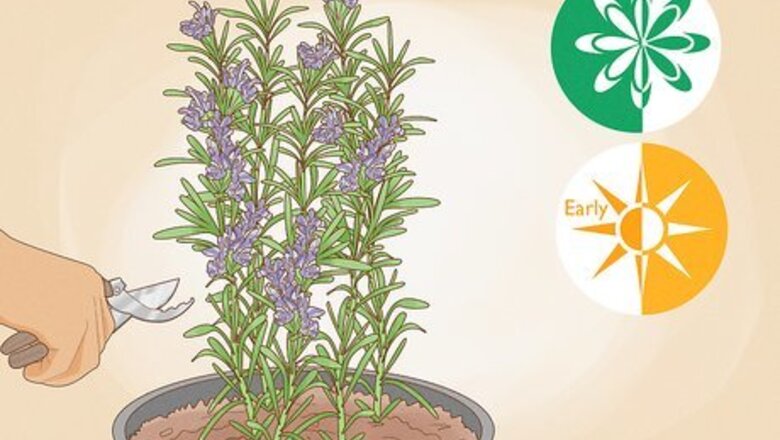
views
Pruning Smaller Plants

Prune your rosemary in spring or early summer. The best time to prune rosemary is between March and June, when the warm weather and plentiful sunshine will help produce healthy new foliage. However, you can also begin as early as the last weeks of winter, or hold off until things start cooling off in the fall. A good rule of thumb is to schedule your last trim of the season no later than 4-6 weeks before the earliest expected frost. This will give the new growth a chance to harden off before the temperature outside plummets. Get in the habit of pruning your rosemary around the same time every year. Regular attention will allow it to flourish.
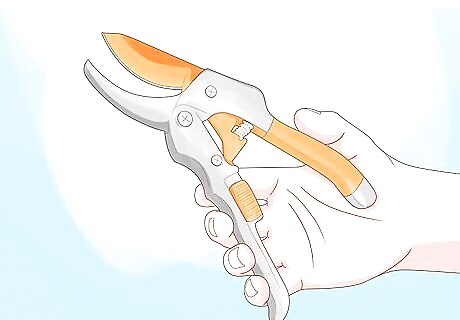
Use a sharp pair of pruning shears. If necessary, purchase a new set of shears or have a well-worn older pair sharpened before you get started. The sharper the blades, the cleaner the cut, and the stronger the branches will grow back as a result. Bypass pruners, which feature overlapping blades that move past one another as they close, tend to make cleaner cuts than traditional scissor-style shears. The ragged cuts created by dull blades could leave your rosemary vulnerable to pests or infectious diseases.
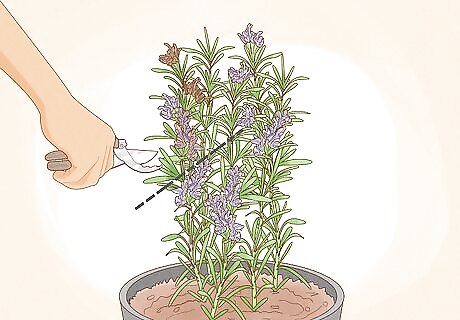
Remove dead or faded flowers. To prune large plants, start by snipping the spent flowers or gently pulling them off by hand. Focus on flowers that show signs of damage or are beginning to lose their color. Leave healthy blooms intact. Mature rosemary shrubs put out delicate blue, pink, purple, or white blossoms which give them aesthetic as well as culinary value. Rosemary flowers are actually edible, so consider saving a few of the blooms that appear to be in better shape.

Do away with damaged or diseased shoots. Cut stems that have been killed off by frost back to their first set of green leaves. Do the same for low-lying branches that show signs of fungal infection, such as drooping or discolored foliage. If the entire branch or stem appears to be affected, it's usually best to get rid of the whole thing to keep the condition from spreading. Spreading 1–2 inches (2.5–5.1 cm) of sand or pea gravel over the base of your rosemary plant can go a long way in preventing fungal diseases by helping the growing soil dry out faster.
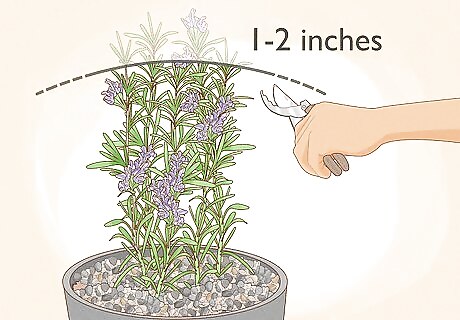
Trim 2–3 inches (5.1–7.6 cm) from the outermost stems. Use a pair of sharp pruning shears to clip the stems at a slight angle. Cleaning up the most developed offshoots stimulates new growth—sometimes, a single stem may even branch off into 2 separate stems when it grows back. Avoid cutting below the lower leaves. Removing too much greenery can inadvertently harm the foliage, causing the plant to grow only bare woody branches. Container-raised rosemary growing indoors should be pruned the same way.
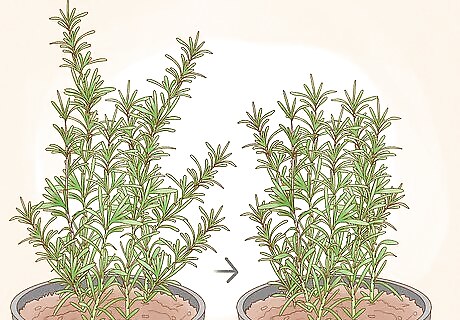
Shape your rosemary as desired. Keep the depth and angle of each cut consistent to give the plant a neat, well-manicured appearance. Try to avoid making it look too uniform, though. Rosemary is naturally bushy, so it’s okay for it to be a little thicker in some spots. You can also focus on one part of the plant for more practical pruning. If your rosemary shrub is overtaking a nearby plant or stretching out into a walkway, for instance, cutting back those sections will help open things up and create space.
Cutting Back Large, Woody Shrubs
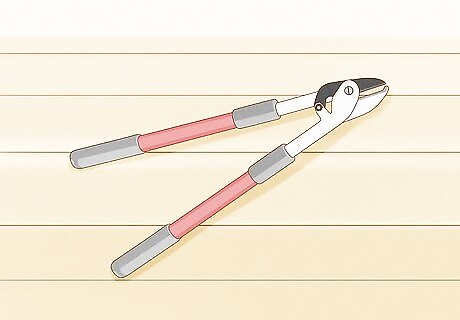
Use a pair of loppers to clip thicker branches. While ordinary pruning shears will usually enough to take a couple inches off the top, you’ll need a heavy-duty tool to tackle the woodier sections closer to the base of the plant. Long-handled loppers offer better leverage and are useful for severing branches without mangling them and disrupting healthy new growth. When pruning with loppers, be sure to pull on a pair of rugged gardening gloves to protect your hands from the rough wood and prickly leaves of the plant’s inner reaches. It may even be necessary to equip yourself with a small handheld pruning saw in order to get through the hard branches at the bottom of especially large shrubs.
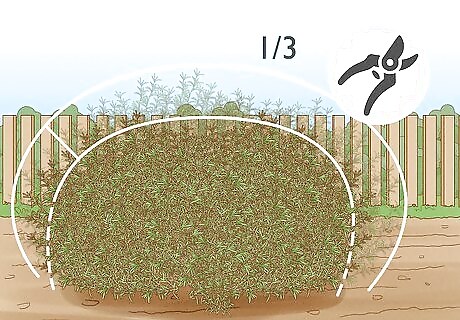
Cut back overgrown plants to a third of their total size. The simplest way to do this is to lop off any branches you find that are dead or no longer producing foliage. If you want to keep your rosemary the same height, you can also cut every third branch to thin it out without shrinking its overall dimensions. Cutting back your rosemary by more than a third could kill it off by leaving only non-productive growth remaining. The practice of eliminating a significant amount of foliage from woody plants is known as "rejuvenation pruning," and can be useful for saving plants that are failing due to disease or exposure to harsh weather.
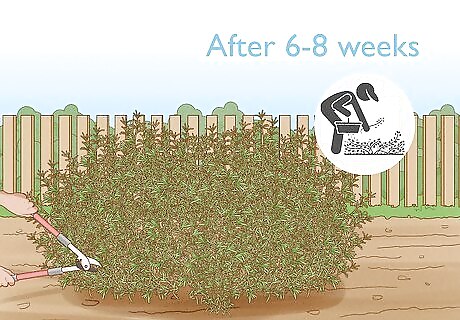
Touch up plants you've thinned after 6-8 weeks. Wait for the first set of branches to begin growing back, then cut a third of the remaining offshoots. If necessary, you can repeat this process again after another 6-8 weeks. By doing heavier pruning in phases, you can be sure that you’re not taking off too much at once. Hold off on cutting each next set of branches until the previous sections have returned to their original size. Otherwise, your rosemary will end up smaller than it was before you started. This step will only be necessary if you've chosen to remove every third branch from an outdoor rosemary plant in order to preserve its size.

Tidy up criss-crossing branches. Inspect the interior of the plant for woody shafts that are entwined or growing in opposing directions. When you find them, do away with 1 of the 2 branches. This will prevent bigger branches from competing for space or potentially choking each other out. Opening up the inside of the plant also enhances airflow, which makes fungal diseases less likely to develop.
Putting Your Rosemary Clippings to Good Use
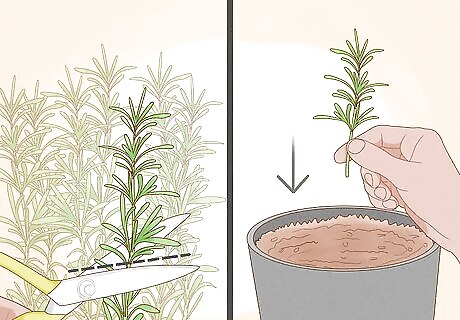
Replant the clippings to grow new plants. Rather than throwing out the nice green bits leftover from pruning, float them in a cup of fresh water until they begin to sprout roots. Then, place them in a small container filled with equal parts peat moss and perlite. Transfer the plants to a larger container or move them into your garden once the roots get too large for the original container. A well-balanced commercial potting soil containing organic amendments can also encourage the new rosemary plants to take root. By propagating your rosemary clippings, you can multiply the number of healthy, productive plants in your home or garden for no cost.

Add fresh rosemary leaves to your favorite dishes. The most common use for rosemary, of course, is as a seasoning. Throw a few whole sprigs into a rich sauce or marinade, or sprinkle the leaves directly onto meats, vegetables, and baked goods for an extra touch of aromatic flavor. You can also dry unused leaves to preserve them for future use. Store recently-cut herbs in an airtight container and store them in a cool, dark place. The bold, piney notes of fresh rosemary tend to go best with savory offerings.
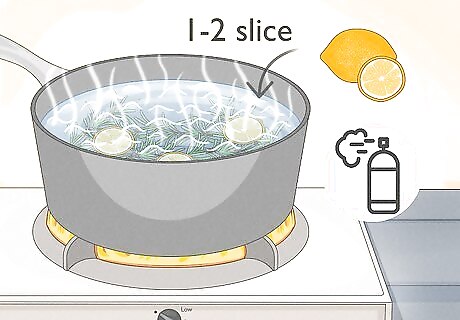
Use rosemary as a natural air freshener. Simmer 3-4 sprigs of rosemary with 1-2 sliced lemons in a small saucepan of water over low-medium heat. As the mixture warms up, the heat will unlock the essence of each individual component to fill your home with a fresh, earthy scent. For an even more, stir in 1-2 whole vanilla beans or ½ teaspoon of vanilla extract. A single pan of stewed rosemary potpourri can keep the air in your home smelling pleasant for up to 2 days.




















Comments
0 comment